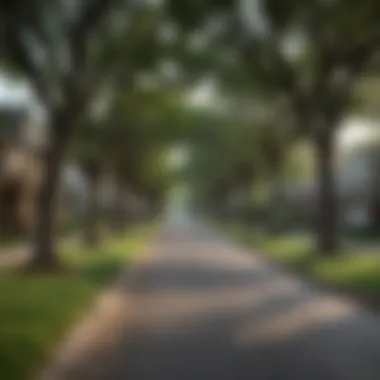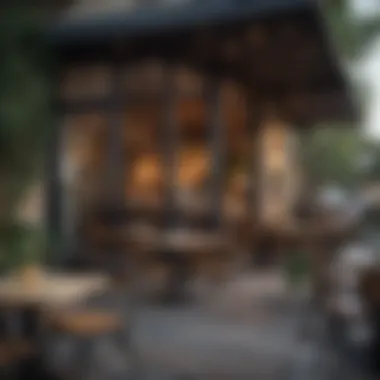Exploring Good Neighborhoods in Austin: A Comprehensive Guide


Intro
Austin, Texas, is renowned for its unique fusion of urban life and vibrant cultures. As the city grows, choosing the right neighborhood becomes increasingly vital for both newcomers and long-time residents. The factors influencing neighborhood selection are numerous, ranging from local amenities to the prevailing real estate trends. This guide seeks to unravel these complexities. It aims to inform on how to seek out good neighborhoods, ensuring that choices align with individual lifestyles and personal preferences.
In looking for suitable areas, various elements merit consideration. Understanding amenities like parks, schools, transportation, and shopping options can shape daily life. Awareness of real estate trends, including pricing and availability, is also crucial. Furthermore, one must appreciate cultural influences and community engagement that contribute to the social fabric of each neighborhood. This guide endeavors to provide substantial insight into specific neighborhoods known for their distinct characteristics and overall living experience, ultimately aiding in informed decision-making about which part of Austin to call home.
Featured Homes
In the quest for a good neighborhood in Austin, the type of housing available plays a significant role. Here, we delve into what unique homes can offer.
Spotlight on Unique Architectural Designs
Austin showcases a diverse array of architectural styles. From mid-century modern homes in Tarrytown to the chic bungalows of East Austin, each neighborhood has its own aesthetic charm. These designs reflect the city’s character while catering to various lifestyles. Notable areas with distinctive homes include:
- South Congress: Known for its quirky, eclectic vibe and historic houses.
- Clarksville: Displays charming Craftsman-style homes, ideal for those who appreciate vintage architecture.
- Mueller: Features energy-efficient designs within a master-planned community, blending modern living with eco-consciousness.
Wherever you roam in Austin, a unique design can tell a story. Homebuyers often find themselves captivated by these architectural masterpieces that elevate their living experience.
Home Tours: Inside Stunning Interiors
Evaluating homes directly is paramount. In-person tours allow potential residents to experience the flow of spaces, design choices, and ambience. Whether viewing a stunning modern kitchen or an inviting living room, every detail counts. Below are some popular neighborhoods known for their impressive home interiors:
- West Lake Hills offers large estates with sophisticated interiors, perfect for those who appreciate luxury.
- Downtown Austin is home to upscale high-rise condos that provide both comfort and breathtaking views.
- The Domain boasts contemporary apartments showcasing the latest trends in interior design.
Touring homes gives a tangible sense of the potential investment. It helps to visualize life in these spaces and the communities they inhabit.
"Buying a home is not just about real estate; it's about community and lifestyle."
Incredible Locations
Alongside homes, the ambiance of a neighborhood largely stems from its surroundings. Here, we explore the remarkable locations that punctuate Austin’s real estate landscape.
Hidden Gems: Underrated Travel Spots
While Austin is frequently celebrated for iconic spots like the State Capitol, several lesser-known places deserve attention. These hidden gems enhance neighborhood appeal. Consider:
- Mckinney Falls State Park: Offers nature trails and swimming spots, perfect for outdoor enthusiasts.
- The Blanton Museum of Art: A cultural haven that brings art to the community, enriching local life.
- Waller Creek: An emerging area with planned developments that could redefine this part of Austin.
Each of these locations enriches local life by fostering community engagement.
Top Destinations for Home and Culture Lovers
Finding a suitable neighborhood often correlates with proximity to cultural destinations. In Austin, interesting sites abound. Residents can enjoy:
- Rainey Street: Known for its food trucks, bars, and live music, creating a lively nightlife scene.
- Zilker Park: Offers expansive green space, perfect for recreation and events, serving as a gathering point for locals.
- University of Texas: A hub for education and cultural events, benefiting nearby neighborhoods through university programs and activities.
The blend of homes and cultural offerings creates a rich tapestry that not only meets the needs of residents but also nurtures community spirit.
Understanding Neighborhood Dynamics
Neighborhood dynamics encompass various elements that play crucial roles in establishing a community's overall appeal. This can include aspects such as demographics, local culture, economic stability, and even the available amenities. Understanding these dynamics is imperative for anyone considering a move or an investment in Austin. Factors such as safety, accessibility to key services, and proximity to attractions all contribute significantly to how desirable a neighborhood can be.
An informed understanding of these dynamics allows potential residents or investors to assess their own lifestyle needs and preferences against the backdrop of what each neighborhood offers. One resident may prioritize vibrant social scenes, while another may value quiet, family-friendly environments. Thus, the multifaceted nature of neighborhood dynamics informs decisions that are both personal and financial, ultimately impacting resident satisfaction and investment returns.
The Importance of Location
Location serves as the bedrock of any neighborhood's identity and functionality. In Austin, certain areas offer closer proximity to business districts, while others provide lush parks or thriving arts scenes. The benefits of an ideal location cannot be overstated. A neighborhood located near significant work hubs can lead to reduced commutes and thus better quality of life. On the other hand, areas abundant with recreational spaces enhance the living experience, encouraging outdoor activities and community interactions.


Moreover, an advantageous location can drive property values upward. Neighborhoods that maintain good accessibility to public transportation, schools, and commercial centers often see sustained interest from homebuyers and investors alike. This lends to a more vibrant community and promotes economic stability, which enhances the overall livability of the area.
Evolving Urban Landscapes
Urban landscapes in Austin are in a constant state of flux. Factors influencing this evolution include shifts in population demographics, economic growth, and emerging cultural movements. As new developments arise, neighborhoods adapt to accommodate these changes. This adaptability can bring new amenities and services, making previously overlooked areas attractive to newcomers.
For example, East Austin has become a hotspot for innovative cuisine and artistic expressions. This transformation has altered not only the demographic makeup but also the community's offerings. Investors and residents must stay attuned to these changes to fully understand the potential trajectory of their chosen neighborhoods.
In summary, understanding the dynamics of Austin's neighborhoods is essential for making informed choices. The unique characteristics of each area, driven by location benefits and urban evolution, define both living experiences and investment opportunities.
Key Factors in Assessing Neighborhoods
When exploring the neighborhoods of Austin, understanding the key factors that differentiate these areas is essential. The elements of safety, schools, and accessibility play a substantial role in determining the livability of any location. These factors not only impact the quality of life but also can influence property values and community engagement. \n\n### Safety and Security Metrics
Safety is a leading concern for individuals and families when choosing a neighborhood. Metrics such as crime rates, presence of community policing programs, and neighborhood watch initiatives are crucial indicators of safety. In Austin, various neighborhoods have different safety profiles. \n\nReal-time crime mapping tools and local police reports provide valuable data. Moreover, neighborhoods with low crime rates often correlate with higher property values. Therefore, prospective residents often prioritize areas that are statistically safer. Residents may also find comfort in community involvement that fosters a collective sense of security. \n
Quality of Schools and Educational Opportunities
Education is a significant consideration, particularly for families with children. The quality of schools greatly influences neighborhood desirability. In Austin, some areas boast highly-rated public schools, while others may offer specialized private institutions or charter schools. \n\nResearching school performance metrics, such as graduation rates and student-teacher ratios, can help gauge educational opportunities. Additionally, areas with various colleges and universities present expanded options for higher education, appealing to a broader demographic. Neighborhoods with quality education systems generally maintain higher real estate values, reflecting the strong demand for homes in these regions. \n
Accessibility and Transportation Options
Ease of transportation is another vital consideration. Austin has a variety of public transport options, including buses, metro lines, and bike paths. Neighborhoods that provide easy access to major highways and public transit systems tend to attract those who value commuting convenience. \n\nWalking and biking accessibility enhance a neighborhood's livability, promoting healthier lifestyles. Proximity to essential services, grocery stores, and entertainment can also be a determining factor. A balance between public transport options and walkability is crucial, as it contributes to the overall appeal of the community. \n In summary, assessing neighborhoods in Austin requires a focused approach on these key factors—safety, education, and accessibility. By carefully evaluating these elements, residents and newcomers can make informed decisions that reflect their lifestyle preferences and expectations.
Popular Neighborhoods in Austin
Exploring the concept of popular neighborhoods in Austin provides valuable insight for both residents and newcomers. Each area not only has its own characteristics, but also reflects the diverse lifestyle options available in this vibrant city. When considering where to live, it is essential to assess amenities, social dynamics, and real estate trends specific to each neighborhood.
Downtown Austin
Cultural Attractions
Cultural attractions in Downtown Austin contribute significantly to its livability. This area serves as a hub for art, music, and festivals. The presence of venues like the Austin City Limits and the annual South by Southwest (SXSW) festival demonstrates why many find this area appealing. The bustling nightlife and varied cultural expressions attract both locals and tourists alike. An appealing aspect of these cultural attractions is their ability to foster a sense of community and engagement among residents, enhancing the overall experience of living in Downtown.
Dining and Entertainment
Dining and entertainment options abound in Downtown Austin, making it a desirable location for food enthusiasts and nightlife seekers. The notable presence of diverse restaurants, from Texas barbecue to international cuisine, satisfies a wide range of palates. Unique features like food trucks and local breweries add to the charm of these options. However, with this popularity comes potential downsides such as higher prices and crowded venues during peak hours, which can deter some from fully enjoying the experience.
Real Estate Trends
Real estate trends in Downtown Austin reflect the city's growth and appeal. The area has seen a surge in new developments, both commercial and residential. This growth indicates a strong demand for housing, particularly among young professionals and those seeking a vibrant urban lifestyle. Nonetheless, with increased demand comes rising property values, making it essential for potential buyers or renters to be informed about market conditions.
South Congress (SoCo)
Unique Vibe
The unique vibe of South Congress adds an eclectic charm to the neighborhood. Known for its vibrant street art, vintage shops, and strong local culture, it distinguishes itself from other areas in Austin. This distinctive atmosphere appeals to those who appreciate individuality and creativity. However, the area's popularity can lead to more foot traffic, which some may find overwhelming.
Shopping and Art
Shopping and art are integrated seamlessly in South Congress, enhancing the neighborhood's attraction. The combination of boutique stores, galleries, and quirky shops creates an engaging experience for residents and visitors. Unique features, such as local artisans showcasing their works, contribute to the neighborhood's charm. Although this lively shopping scene is a significant draw, it may present a downside with increased noise and congestion during peak shopping times.
Community Events
Community events play a crucial role in fostering connections among those in South Congress. Regular activities such as art walks and local fairs allow residents to engage with one another and celebrate the neighborhood's culture. This sense of community is an important characteristic that makes living in SoCo appealing. However, event organization can lead to disruptions, particularly regarding traffic and accessibility, which may not please everyone.
Travis Heights


Historic Homes
Historic homes define the character of Travis Heights, encompassing a rich historical narrative. The diverse architectural styles paint a picture of the neighborhood’s evolution. Many residents are drawn to these homes for their charm and significance. This connection to history can enhance the living experience, though some of these homes may require significant maintenance, which can be a challenge for homeowners.
Parks and Green Spaces
Parks and green spaces are vital attributes of Travis Heights, providing residents with recreational options. Notable parks like Alamo Park offer beautiful landscapes for relaxation and outdoor activities. These spaces enhance the quality of life by promoting healthy lifestyles and interactions among community members. However, with rising populations, maintaining these green spaces can be a challenge.
Family-Friendly Environment
Travis Heights promotes a family-friendly environment. Amenities such as quality schools and community centers create an ideal setting for families. The welcoming nature of the neighborhood makes it attractive for parents seeking more than just a home. Despite this, the increasing popularity could lead to a more competitive atmosphere regarding housing and local resources.
East Austin
Diverse Culture
Diverse culture defines East Austin, offering a rich tapestry of influences. The melding of traditional and modern elements creates a vibrant atmosphere that appeals to many. This cultural richness fosters a sense of belonging for residents and attracts newcomers looking for authentic experiences. Notably, the cultural shifts may make the area more competitive, affecting affordability.
Gastronomy Scene
The gastronomy scene in East Austin is a significant draw for food lovers. The influx of restaurants and cafes specializing in various cuisines showcases the area's dynamic food culture. Unique features like farm-to-table dining and food festivals emphasize the community's culinary creativity. However, the rapid growth could lead to challenges such as increased wait times during peak hours.
Artistic Community
An active artistic community thrives in East Austin. Local artists contribute through murals, galleries, and performances, enriching the neighborhood's social fabric. This engagement encourages a sense of pride and involvement among residents. Nevertheless, the popularity of the arts may also lead to gentrification, which could alter the neighborhood's character over time.
West Lake Hills
Scenic Views
Scenic views are a defining characteristic of West Lake Hills. The picturesque landscapes attract those who value natural beauty within their living environment. Residents enjoy the tranquility and aesthetic appeal this area offers. However, the elevation can sometimes present accessibility challenges for some individuals and families.
Exclusivity
Exclusivity marks West Lake Hills as a prime location for affluent families. This characteristic fosters a sense of prestige and security, making it appealing to those seeking an upscale lifestyle. Nonetheless, this exclusivity may lead to a limited sense of community due to the higher turnover and transient nature of its residents.
Top-rated Schools
Top-rated schools are a key consideration for families in West Lake Hills. The reputation of local schools contributes to the desirability of the area, serving as a significant factor in real estate decisions. Parents often prioritize educational opportunities for their children when choosing where to live. However, high demand for these schools can create overcrowding issues and strain local resources.
Real Estate Insights
Understanding the real estate landscape is crucial for both current residents and newcomers to Austin. Real estate insights not only provide clarity on market dynamics but also emphasize the socioeconomic factors influencing neighborhood desirability. The information regarding property values, rental prices, and trends can lead to informed decisions. For families, professionals, or investors, grasping these insights means aligning choices with personal and financial goals. This section dissects the current market trends and potential investment opportunities, rounding out a well-developed view of the housing scene in Austin.
Current Market Trends
At present, the Austin real estate market reveals a robust trajectory. Home prices have been on a constant upward trend, largely fueled by high demand driven by tech industry growth and an influx of new residents. In fact, according to the Austin Board of Realtors, the median home price has reached astounding figures in recent months.
Factors contributing to this trend include:
- Population Growth: With people migrating from different states, living in Austin is increasingly appealing.
- Employment Opportunities: Major companies, including Dell and Apple, have established a strong presence in Austin, attracting talent.
- Quality of Life: The vibrant culture, entertainment options, and educational institutions make the city popular.
However, it is critical to approach this booming market with caution. Rising prices can lead to considerations about long-term investment value versus short-term gains. Analyzing neighborhood appreciation rates helps identify where value might hold the strongest prospects.
Investment Opportunities
Austin offers inviting opportunities for real estate investment, appealing to both seasoned investors and first-time buyers. Several factors enhance the investment climate:


- Diverse Property Types: From single-family homes to condos, investors can choose based on target market and budget.
- Rental Potential: With continuous population growth, demand for rentals remains high. Short-term rental platforms like Airbnb have gained traction, increasing passive income opportunities.
- Future Development: Ongoing infrastructure projects are set to enhance neighborhood appeal, possibly leading to increased property values. Looking into upcoming developments can provide insight into which areas are on the rise.
"Success in real estate suggests a balanced approach between aspiration and realistic expectations."
Educating oneself about local dynamics will cultivate smarter, informed decisions in this vibrant and ever-changing city.
Community Engagement and Culture
Community engagement and culture play a crucial role in shaping neighborhoods in Austin. It influences the quality of life for residents and enhances the overall sense of belonging. Communities that actively engage their residents tend to grow into more vibrant and cohesive environments. This involvement fosters connections among people and transforms interactions from merely functional to meaningful. By understanding how engagement initiatives and cultural activities work, one gains insights into how they can improve their living experience in Austin.
Community Events and Activities
Within the bustling urban landscape of Austin, community events serve as essential components for strengthening bonds among residents. Festivals, farmer's markets, and cultural celebrations bring people together to share experiences and support local initiatives.
- Festivals: Events like the Austin City Limits Music Festival not only entertain but also create an avenue for community bonding.
- Local Markets: Weekly farmer's markets provide food, and they embody a spirit of collaboration among local producers and consumers.
- Cultural Celebrations: Events such as Cinco de Mayo celebrate the rich cultural diversity of Austin. They showcase music, art, and food from various cultures, allowing residents to learn about and appreciate different heritages.
Active participation in these events can enhance one's social network and deepen their understanding of the town's dynamics. This engagement cultivates a shared identity and pride within neighborhoods, which is often reflected in collaborative community projects.
Local Organizations and Support Networks
Austin is home to a multitude of local organizations that play an instrumental role in fostering community engagement. These organizations often bridge gaps between residents and essential services, enriching the living experience for everyone.
- Neighborhood Associations: These groups are pivotal in advocating for local needs and fostering interaction among residents. They often organize discussions, events, and initiatives aimed at improving the neighborhood.
- Nonprofit Organizations: Entities such as the Austin Area Urban League work towards community empowerment. They provide resources, education, and support services that can uplift entire neighborhoods.
- Volunteer Networks: Many residents find purpose and connection through volunteering. Whether it’s working with Habitat for Humanity or joining local cleanup efforts, being involved makes one a part of something bigger.
In summary, these organizations not only aid individual residents but help weave a tighter community fabric. They encourage collaboration and offer various resources to ensure all voices are heard.
"Active community engagement leads to more resilient neighborhoods where everyone's contributions are valued."
Understanding and participating in this aspect of community life can significantly enhance one's experience living in Austin. It helps residents integrate into the social fabric of their neighborhoods and fosters long-term relationships with their neighbors.
Future Developments and Urban Planning
Understanding future developments and urban planning is crucial for anyone assessing neighborhoods in Austin. This field encompasses a variety of elements that influence the livability and attractiveness of an area. Well-planned urban spaces enhance community pride, improve access to amenities, and provide a safe and enjoyable environment for residents.
In Austin, rapid growth brings both opportunities and challenges. The city's expanding population requires careful consideration of infrastructure, such as roadways, public transportation, parks, and commercial spaces. Thoughtful planning ensures that neighborhoods remain vibrant and connected while accommodating the needs of their residents.
Upcoming Projects in Austin
Several significant projects are currently shaping the urban landscape of Austin. These projects focus on improving the quality of life, enhancing beauty, and promoting sustainability within the city. Some upcoming developments include:
- Project Connect: This ambitious transit plan aims to enhance the public transportation network, including light rail, bus rapid transit, and improved bus services. The goal is to provide residents with more accessible travel options, thus reducing traffic congestion and pollution.
- The Domain Expansion: This mixed-use development is being expanded to increase retail, dining, and residential options. The Domain continues to attract businesses and is becoming a central hub for both shopping and entertainment within the city.
- Green Urban Spaces: Several parks and green spaces are being developed or renovated across the city to promote outdoor activities and enhance community engagement. These spaces include walking trails, playgrounds, and recreational areas for families to enjoy.
These projects are not just about infrastructure; they embody the city's vision for a sustainable future, achieving a balance between growth and preservation of community identity.
Impact on Neighborhood Livability
Ongoing developments and urban planning have a significant impact on neighborhood livability in Austin. When urban areas are effectively developed, residents benefit from improved safety, accessibility, and quality of life. Considerations for livability include:
- Increased Connectivity: As transportation options improve, residents can expect reduced travel times and easier commutes. Enhanced public transport will connect previously isolated areas, allowing for a more inclusive community.
- Enhanced Amenities: New commercial projects lead to more shopping, dining, and entertainment choices. Local businesses thrive, and the availability of amenities contributes to an enhanced living experience.
- Sustainability: Urban planners focus on sustainable practices, ensuring that developments are environmentally friendly. This includes prioritizing green buildings, eco-friendly transportation systems, and preserving natural landscapes.
- Community Engagement: By integrating public spaces into developments, residents are more likely to participate in community events and activities. Engaging environments foster a sense of belonging and improve overall quality of life.
Understanding urban planning's role in neighborhood livability helps residents make informed choices about where to live and invest.
Ending
In the context of this article, the conclusion serves as a pivotal element in synthesizing the insights gathered from exploring good neighborhoods in Austin. It connects the various themes presented throughout, offering a holistic view of what makes a neighborhood desirable. As we navigate the complexities of urban living, understanding neighborhood dynamics becomes essential. This article emphasizes the significance of location, safety, community engagement, and real estate trends.
Making Informed Choices
The ability to make informed choices regarding neighborhood selection cannot be overstated. It involves a careful consideration of personal needs, preferences, and lifestyle. Here are some specific elements to think about:
- Safety: Research crime statistics in potential neighborhoods. Websites like Reddit can provide personal insights from residents.
- Schools: Access to quality educational institutions can greatly influence a neighborhood's desirability for families.
- Community: Look for neighborhoods that offer a sense of belonging and opportunities for engagement.
- Amenities: Consider proximity to parks, shopping, and dining to ensure a comfortable lifestyle.
These considerations provide a foundation for evaluating neighborhoods. Homebuyers or renters should engage in discussions with local real estate agents or visit forums on platforms like Facebook to gather diverse perspectives.
Ultimately, choosing the right neighborhood involves a deep understanding of personal and community values. By focusing on these key aspects, individuals can enhance their living experience in Austin, ensuring that their selected neighborhood aligns with their aspirations.







